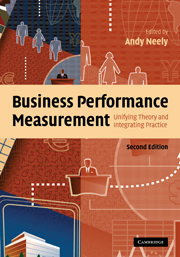Book contents
- Frontmatter
- Contents
- List of figures
- List of tables
- List of boxes
- List of contributors
- Introduction
- Part I Performance measurement – functional analyses and theoretical foundations
- Part II Performance measurement – frameworks and methodologies
- Part III Performance measurement – practicalities and challenges
- Part IV Performance measurement in public services
- 16 Measuring the performance of England's primary school teachers: purposes, theories, problems and tensions
- 17 Police performance: sovereignty, discipline and governmentality
- 18 The development of composite indicators to measure health care performance
- 19 Perversity in public service performance measurement
- Part V Performance measurement – emerging issues and enduring questions
- Index
- References
19 - Perversity in public service performance measurement
Published online by Cambridge University Press: 22 September 2009
- Frontmatter
- Contents
- List of figures
- List of tables
- List of boxes
- List of contributors
- Introduction
- Part I Performance measurement – functional analyses and theoretical foundations
- Part II Performance measurement – frameworks and methodologies
- Part III Performance measurement – practicalities and challenges
- Part IV Performance measurement in public services
- 16 Measuring the performance of England's primary school teachers: purposes, theories, problems and tensions
- 17 Police performance: sovereignty, discipline and governmentality
- 18 The development of composite indicators to measure health care performance
- 19 Perversity in public service performance measurement
- Part V Performance measurement – emerging issues and enduring questions
- Index
- References
Summary
Introduction: government, targets and measurement
The last twenty years have seen the use of performance measurement and performance management mushroom in government departments and agencies in the United Kingdom and elsewhere. A review of the use of performance measurement in various countries can be found in Public Management Reform: A Comparative Analysis, by Pollitt and Bouckaert (2004). Performance measurement is not a new feature of public administration, but it has become much more prominent in the United Kingdom, the United States, New Zealand and some other countries during the last two decades. A positive review of these developments in the United Kingdom was produced by the government's Comptroller and Auditor General in 2001 (National Audit Office, 2001). A rather more critical review can be found in the report produced by the Public Administration Select Committee in 2003 following its extensive discussions (Public Administration Select Committee, 2003).
There are many different aspects of the public sector that could be measured. These include issues of productivity, traditionally the domain of economists, which was the major concern of the Atkinson Review (Office of National Statistics, 2005), set up by the National Statistician “to advance methodologies for the measurement of government output, productivity and associated price indices in the context of the National Accounts …”.
Information
- Type
- Chapter
- Information
- Business Performance MeasurementUnifying Theory and Integrating Practice, pp. 408 - 430Publisher: Cambridge University PressPrint publication year: 2007
References
Accessibility standard: Unknown
Why this information is here
This section outlines the accessibility features of this content - including support for screen readers, full keyboard navigation and high-contrast display options. This may not be relevant for you.Accessibility Information
- 2
- Cited by
